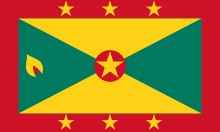GRENADA
 Grenada (310 sq km) and a part of the Grenadines islands – among them Cariacou (27 sq km) and Petit Martinique (5 sq km) – constitute this state of the Lesser Antilles. The total land’s area is 342 sq km.
Grenada (310 sq km) and a part of the Grenadines islands – among them Cariacou (27 sq km) and Petit Martinique (5 sq km) – constitute this state of the Lesser Antilles. The total land’s area is 342 sq km.
The centre of Grenada is humid, steep and covered with forest. Sainte-Catherine Mount (840m) which is an extinct volcalno is the highest summit of the island.
In the wooded area live Mona monkeys, native of West Africa, opossums, mangooses, three species of boa, birds like hummingbirds, pelicans, milans, balbuzards are present too. Among the trees that make up the flora, there are palm tree, breadfruit tree, flamboyant etc. Grenada is nicknamed “Island of Spices” ; it is the world’s second nutmeg producer. The nutmeg tree (Myristica Frangans) native of India was brought to Grenada by the Dutch in the 19th century. The country also exports cinnamon, cloves, ginger, macis, banana and cocoa ; it produces chocolate. Besides agriculture and fishing, tourism is an important part of the economy since the 1980s.
Christopher Columbus discovered Grenada in 1498 during his third voyage to the West Indies but he did not went ashore.
In 1609, over 200 British settlers tried to grow tabacco there but, next year, almost all of them were massacred by the Carib Indians. In 1650, Du Parquet (governor of Martinique) “bought” Grenada from the Amerindians for cheap junks (small axes, two bottles of brandy, some glass pearls…). Then, 200 French settled near to the lagoon of St George’s where they created a trade. Next year, after several attacks because some Caribs disapproved of this land deal, the French soldiers decided to chase the Amerindians out Grenada. Men, women and children committed suicide jumping off the cliffs in Sauteurs Bay (in the north of the island). The French colonists imported African slaves to grow sugar cane, tabacco, indigo, coconut palms…
In 1762, the British admiral George Rodney conquered Grenada. In the end, the Treaty of Paris gave up Grenada to the English. But sometimes, the cohabitation between British settlers and minority French planters was difficult.
In 1795, French Catholics influenced by French Revolution revolted. They captured the British governor with other people and killed them. They controled a large part of the island for more than a year when arrived the British Navy to subdue the rebels. Their leader, Julien Fedon, a Black French planter, never was captured.
In 1877, Grenada gained the British colony status.
In 1967, Grenada became a state within the Commonwealth. On February 7th, 1974, Grenada, Cariacou and Petit Martinique became an independent state.
But this Caribbean island made the headlines when Maurice Bishop seized power on March 13th, 1979 without violence. The new Prime Minister, a 34-year-old lawyer, although supported by the population was isolated by the conservative West because of its socialist ideas and his politics of non-alignment. Then, he became very close to Cuba. In October, 1983, the army overthrew Bishop then 30 000 people went to Fort George to demand his freedom. 40 demonstrators were killed, Bishop and some supporters were executed without sentence. October 25th, 1983, American troops supported by some Caribbean States invaded Grenada. More than 280 people (170 Grenadians among them18 in a psychiatric hospital, 70 Cubans and 42 Americans) were killed in these fights. New elections were organized in 1985. As for 14 people responsible for Maurice Bishop’s murder, they were sentenced to life imprisonment.
Today, the island which is always a member of the British Crown and lives under a parliamentary system led by a Prime Minister, has found again its peace.
Area : 342 sq km (132 sq miles)
Population : 110 600 inhabitants
Capital : St George’s
Language : English
Currency : Eastern Caribbean Dollar (EC$)
People : Grenadians
